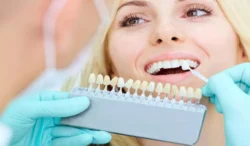Bridges are celebrated feats of the dental industry’s ingenuity. These restorative procedures are designed to perfectly fit into areas of the smile with one or a few missing teeth. Not only capable of rejuvenating the appearance of an imperfect smile, dental bridges are effective methods to reintroduce the intended functionality of the jaw- refining a patient’s ability to speak and chew.
Dental bridges consist of one or more artificial teeth; crafted from capable and durable materials such as porcelain. This ensures a perfect fit anchored into the fabric of your smile, and their appearance remains indistinguishable from that of your natural teeth.

To gain a better understanding of this topic and much of what they entail, let’s go over some typical questions patients inquire about regarding dental bridges.
How Does the Process Work?
The process behind dental bridges is akin to various other types of similar restorative procedures, such as dentures and implants. However, there are unique elements which differentiates this process from the other options:
- A dental professional will initiate the procedure by prepping and cleaning the area of your smile which will house the new bridge.
- The surrounding teeth, which act as the bridge’s anchor, will likely have portions of enamel removed to make room for the artificial crowns to be placed above.
- This now allows them to craft an accurate impression for the future artificial tooth or teeth.
- In the interim period, a temporary bridge is fastened as a substitute to protect your smile until your permanent bridge is ready.
- An appropriate color is then chosen for the bridge to best assimilate into the rest of your existing smile.
- In a follow up appointment, the now crafted and now completed bridge is placed, effectively cementing it into your oral anatomy.
Unlike the implant process, bridges don’t require drilling into the actual jawbone as they utilize a less invasive approach.
Will Any of My Existing Teeth Be Impacted?
To some extent, yes. Bridges go beyond a crown, as they need to alter the surrounding existing teeth to some extent to fill in the missing gap. While dental professionals will always adopt the most conservative approach when performing alterations to the already healthy parts of your smile, the neighboring teeth usually will have to have enamel shaved down for the anchoring crowns to be placed on top. This provides the middle section of the bridge, consisting of the replacement tooth (pontic), with structural support. Granting it the ability to fully stabilize into the empty gap and cement itself into the fabric of your smile.

For many patients though, the surrounding teeth may already have issues which require crowns or other restorative corrections anyways. So dental bridges in many cases, are capable of killing two birds with one stone!
Are They Permanent?
While not lasting a lifetime, dental bridges are still considered more permanent mechanisms to enhance your smile, unlike other restorative methods like dentures. Bridges are crafted from durable materials which are cemented into place, and thus boast a lifespan of up to and even beyond 15 years if managed properly.
Patients who commit to a vigorous oral care routine and participate in a healthy lifestyle will almost always live with their dental bridges for years longer than those who lag behind in these practices.
Will It Be Difficult to Eat?
Identical to any other procedure, there is an adjustment period of a few days until you become fully accustomed to your smile’s new additions. In the period directly following their installation, it will be recommended to consume softer substances and cut your food up into smaller pieces. However, once you fully adapt to your dental bridges, they are guaranteed to greatly enhance your ability to eat for at least the decade ahead.
Will It Worsen My Speech?
On the contrary! Patients with missing teeth often have difficulty speaking properly; often experiencing trouble with forming and annunciating words as the teeth assist in speech through controlling the airflow in and out of the mouth. Therefore, a process like bridges which restores areas of the mouth missing those crucial teeth, will drastically improve your speaking capabilities!
How Do I Care for Them?
The bridge becomes an integral part of your oral anatomy, and should be treated the exact same as any other natural tooth. While being crafted from durable materials such as porcelain, ceramic, and resin, the tooth will not decay over time. However, it is still a member of your smile’s ecosystem and will attract bacteria buildup throughout the day.
Patients are instructed to strictly follow the guidelines of their dental professional to ensure these bridges enjoy a long and healthy lifespan. This includes brushing your teeth twice a day (especially after meals) and flossing at least daily- especially between the crevasses of the new dental bridge and its surrounding area.
Always keep in mind, the best line of defense to ensure the success of dental bridges or any oral procedure are continuous check up appointments with a professional every six months or so!
If you have any other thoughts, questions, or concerns about dental bridges, or believe they may be the right solution to your smile’s situation please book a consultation appointment today!






